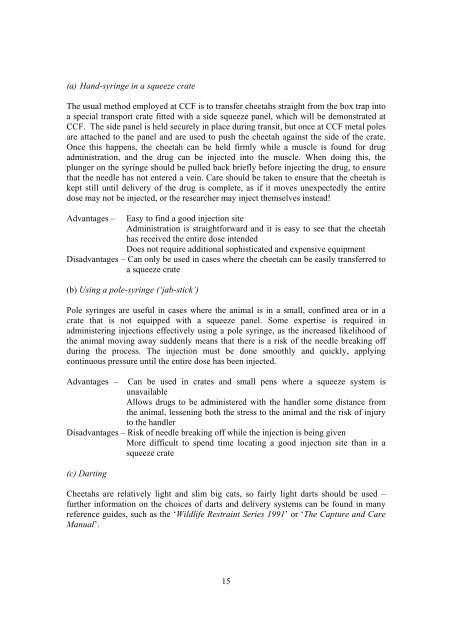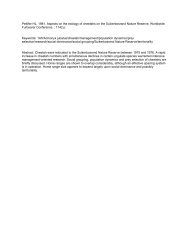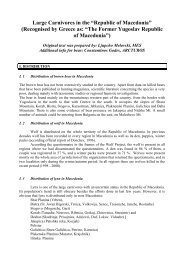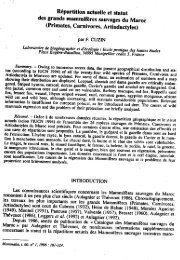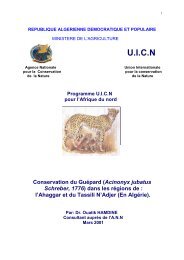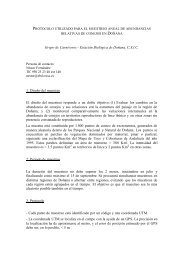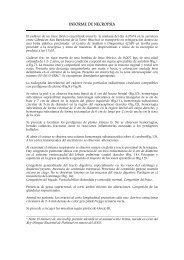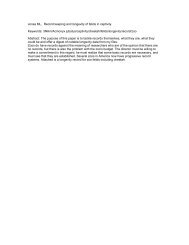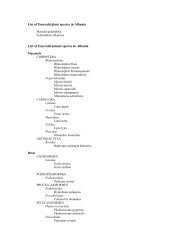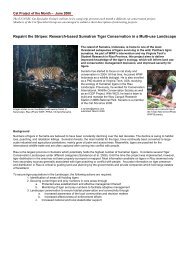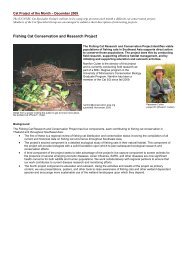cheetah capture and immobilisation handbook - Cat Specialist Group
cheetah capture and immobilisation handbook - Cat Specialist Group
cheetah capture and immobilisation handbook - Cat Specialist Group
Create successful ePaper yourself
Turn your PDF publications into a flip-book with our unique Google optimized e-Paper software.
(a) H<strong>and</strong>-syringe in a squeeze crate<br />
The usual method employed at CCF is to transfer <strong>cheetah</strong>s straight from the box trap into<br />
a special transport crate fitted with a side squeeze panel, which will be demonstrated at<br />
CCF. The side panel is held securely in place during transit, but once at CCF metal poles<br />
are attached to the panel <strong>and</strong> are used to push the <strong>cheetah</strong> against the side of the crate.<br />
Once this happens, the <strong>cheetah</strong> can be held firmly while a muscle is found for drug<br />
administration, <strong>and</strong> the drug can be injected into the muscle. When doing this, the<br />
plunger on the syringe should be pulled back briefly before injecting the drug, to ensure<br />
that the needle has not entered a vein. Care should be taken to ensure that the <strong>cheetah</strong> is<br />
kept still until delivery of the drug is complete, as if it moves unexpectedly the entire<br />
dose may not be injected, or the researcher may inject themselves instead!<br />
Advantages – Easy to find a good injection site<br />
Administration is straightforward <strong>and</strong> it is easy to see that the <strong>cheetah</strong><br />
has received the entire dose intended<br />
Does not require additional sophisticated <strong>and</strong> expensive equipment<br />
Disadvantages – Can only be used in cases where the <strong>cheetah</strong> can be easily transferred to<br />
a squeeze crate<br />
(b) Using a pole-syringe (‘jab-stick’)<br />
Pole syringes are useful in cases where the animal is in a small, confined area or in a<br />
crate that is not equipped with a squeeze panel. Some expertise is required in<br />
administering injections effectively using a pole syringe, as the increased likelihood of<br />
the animal moving away suddenly means that there is a risk of the needle breaking off<br />
during the process. The injection must be done smoothly <strong>and</strong> quickly, applying<br />
continuous pressure until the entire dose has been injected.<br />
Advantages – Can be used in crates <strong>and</strong> small pens where a squeeze system is<br />
unavailable<br />
Allows drugs to be administered with the h<strong>and</strong>ler some distance from<br />
the animal, lessening both the stress to the animal <strong>and</strong> the risk of injury<br />
to the h<strong>and</strong>ler<br />
Disadvantages – Risk of needle breaking off while the injection is being given<br />
More difficult to spend time locating a good injection site than in a<br />
squeeze crate<br />
(c) Darting<br />
Cheetahs are relatively light <strong>and</strong> slim big cats, so fairly light darts should be used –<br />
further information on the choices of darts <strong>and</strong> delivery systems can be found in many<br />
reference guides, such as the ‘Wildlife Restraint Series 1991’ or ‘The Capture <strong>and</strong> Care<br />
Manual’.<br />
15


